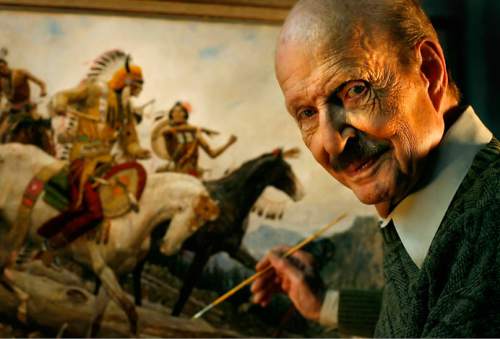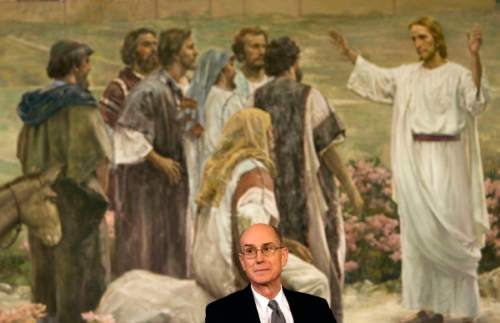This is an archived article that was published on sltrib.com in 2016, and information in the article may be outdated. It is provided only for personal research purposes and may not be reprinted.
Enter the North Visitors' Center on LDS Temple Square in downtown Salt Lake City and you can't miss them: 10 life-size oil paintings that march along a curving wall.
The paintings illustrate the life of Jesus. Here is John baptizing Jesus, there is Jesus gathering disciples from simple fishermen. Another shows Jesus entering Jerusalem on the back of a donkey, and in another he is crucified between two thieves.
In all of the paintings there is little room for interpretation about who is being depicted: Jesus glows with an otherworldly light.
But if the message is hard to miss, so is something about the medium. Everyone is spit-spot clean and all of the paintings seem set more in the green valleys not far from the Great Salt Lake than on the dry, brown shores of Galilee.
There are even American wildflowers — lilies of the valley, bluebells and buttercups — at the feet of Jesus as he preaches.
But to focus on the quality of the art — commissioned by the church in the 1960s from artist Harry Anderson — is to miss the point. This is what Mormons call "gospel art," and they revere it less for its artistic merits and more for its religious purpose — to convey the message and doctrine of Mormonism, which binds its 15 million-plus members worldwide.
The North Visitors' Center is full of works that tell the story of the Old and New Testaments with a Cecile B. DeMille feel. The Church History Museum across the street has its share, too — much of it depicting scenes from the life of Joseph Smith, the New York farmer who founded the church in 1830. The nearby Conference Center houses a collection of paintings of scenes from the faith's signature scripture, the Book of Mormon — battles, baptisms and strapping warriors on an epic scale.
These images and many like them have graced publications of The Church of Jesus Christ of Latter-day Saints for generations. Reproductions, available from the church's online media library and from the online retailer LDSArt.com, hang in Mormon homes and church buildings around the world. They are something almost every Mormon sees, every day, everywhere — a kind of backdrop of the faith.
Very little, if any of it, would find a home in a non-Mormon museum, except perhaps for its historical value.
"You don't have to mince words for me," said Ashlee Whitaker, curator of religious art at Brigham Young University Museum of Art, when asked about the North Visitors' Center art. "Sometimes the quality is not the finish I would hope for."
But, she continued, the art on display here is intended first to teach and then to inspire.
"They give us an opportunity to understand the divinity of Jesus better, to teach ourselves more about Jesus Christ," she added. "That is a priority for us, to seek these teaching moments that give us an opportunity to grow spiritually. These images are a springboard for that in a very real way."
David Morgan, a professor of religion and art at Duke University who has written about Anderson's works, is blunt: "Yes, it is kitsch, but so what? They are not about artistic expression, but about community, about prayer, about devotional feeling. Theses images are the intimate symbols of the community of feeling to which [Mormons] belong."
This art, Morgan said, "is the mental furniture" of the LDS faith.
The development of 'Mormon art'
"Mormon art" exists in a way other scriptural representations do not. And while all religions use art to further their tenets — picture a Catholic Church altarpiece from the medieval period — no Protestant denomination has quite the same relationship to this kind of illustrative art as the LDS Church.
"We are a very visual people, and we want paintings of these religious ideas that matter to us," said Anthony Sweat, a professor of church history and doctrine at LDS Church-owned BYU and a trained artist. "Art is another teaching tool for us."
The church's interest in art dates to 1847. Artists were among those who made the church's epic trip from Nauvoo, Ill., to the Great Salt Lake Basin. They drew landscapes of the "new Zion," as Mormons dubbed Utah, that were used to proselytize for the new faith.
Their "romantic landscapes were linked to their religious faith," church scholar Richard G. Oman wrote. "They saw the face of the Lord in nature and Zion in the purity of the Western wilderness."
By the 1890s, the church was sending "art missionaries" to Paris to train. With the outbreak of World War I, this crop of Mormon artists brought its talent to New York.
In the 1950s, Arnold Friberg, a Mormon artist who taught at the University of Utah, was commissioned to create a series of paintings from the Book of Mormon. They became so popular outside the faith that DeMille put Friberg to work on scenery for his film "The Ten Commandments." Friberg won an Oscar, which cemented his idealized, mid-20th-century style within the church. Visually, they have a lot in common with the children's book illustrations of N.C. Wyeth and the pre-Raphaelite works of Dante Gabriel Rossetti.
Sweat often uses Friberg's art to conduct an experiment with his students. Close your eyes, he asks, and picture the story of wicked King Noah and the prophet Abinadi — a story from the Book of Mormon. How many picture Noah as an overweight man on a throne, he asks, and nearly all hands shoot up. How many see Abinadi as a shirtless, elderly man with an excellent physique? Again, nearly all hands rise. And what kind of pet does King Noah have? The class shouts as one: "Leopards."
The students have all described one of Friberg's most famous and most reproduced paintings, "Abinadi Before King Noah." It has, Sweat said, formed their understanding of the story.
"It's an image with such influence and widespread distribution that it has shaped these artistic interpretations into almost certain facts for an entire generation of church members," Sweat writes of the experiment.
Friberg's popularity set the stage for Anderson, a Seventh-day Adventist who created New Testament scenes for a church display at the World's Fair of 1964-65. Millions of people — Mormons and non-Mormons — saw them at the fair. They have since hung in the North Visitors' Center, which receives upward of 5 million visitors a year.
But are the works of Friberg, Anderson and a dozen other LDS artists whose works dramatize the faith any good? Do they deserve their reverence and place in the hearts and minds of Mormons around the world?
The 'Mormon gaze'
Laura Allred Hurtado says they do.
As curator of the Church History Museum, Hurtado studies all kinds of LDS art, which she describes as a thriving, diverse genre of which gospel art is only a small part. A good sample can be seen in the church's triennial art contest, which attracted 944 entries from artists in 40 countries last year and is displayed on the third floor of the museum.
To compare a work by Anderson or Friberg — or any other gospel artist — to a Michelangelo or a Rembrandt is a mistake, Hurtado said. The expectations we bring to them are different.
"It doesn't have the same aesthetic burden as a Michelangelo because we come to it with a believing gaze, with a Mormon gaze," she said. "We don't interrogate them in the same way."
That Mormon gaze, she said, "becomes part and parcel of the experience" of the art it beholds.
Morgan, the Duke professor, studied the effects of that gaze in "The Forge of Vision: A Visual History of Modern Christianity." Mormons are not the only religious group to bring a specific gaze to religious art, he said, but they bring one that is different from other Protestant groups that have embraced new forms of art and media.
"The images they had 50 years ago still carry a charge of authenticity for them that for many other groups didn't survive," he said. "It is their anchor in time they very deliberately do not want to let go of because it maintains their sense of identity."
That identity includes the belief that Jesus visited America in resurrected form and that the Book of Mormon is "another testimony of Jesus." Having a common set of images reinforces what Mormons see as their specialness.
To sit in front of the Anderson paintings is to watch that theory at work.
"Oh, look, it's that picture," a man, apparently in his 50s, said as he and his female companion approached Anderson's "Sermon on the Mount" in the North Visitors' Center recently. Both wore black name tags identifying them as LDS missionaries.
The man then explained the painting as if he were reading a graphic novel or comic book and filling in the missing speech bubbles. His female companion murmured along with him, then moved on to the next picture in the story.
At the Church History Museum, similar scenes were played out between families. Jason and Mysha Denson brought their three daughters to see the newly remodeled museum from their home in Springville.
Walking before a Gary Earnest Smith rendering of three glowing angels appearing inside the church's Kirtland, Ohio, temple, Mysha tells the children a story all Mormon children learn — how the women there ground up their china to put it in the temple walls so they would sparkle.
"That's sad," said 7-year-old Ella.
"It's not sad," her mother said. "They were happy to give whatever they had for the church."
Denson said she and her husband brought the girls to the museum specifically to see the art — much of which she and Jason remembered from similar visits with their parents and church groups. Asked if the quality of the art was important, she dismissed the question.
"It is so hard for kids to grasp these abstract concepts" like sacrifice and the uniqueness of the church's history, she said. "But here, you can show them a picture and that makes it more real."





